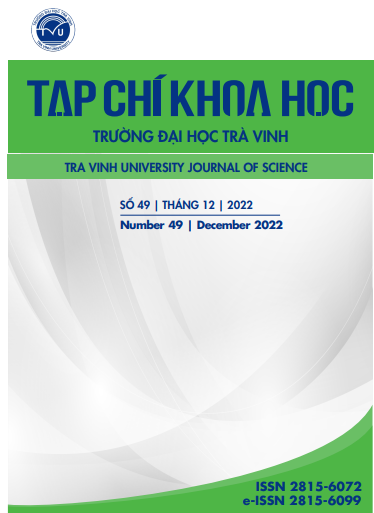STUDY ON MODIFICATION OF YAM STARCH (Dioscorea alata L.) CREATING SLOW DIGESTING STARCH BY ACID HYDROLYSIS
Main Article Content
Abstract
This study was conducted to modify yam starch to create slowly digestible starch (SDS) by the acid method to create the highest SDS starch on the basis of evaluating the effect of citric acid concentration (15 – 45%), temperature (37.5 – 52.5oC) and hydrolysis time (1.5 – 10.5 h) was performed based on the multivariable model
by CCD method, and the starch content SDSmax was the dependent response. The results showed that the quadratic model obtained is significant (p < 0.05), the reliability of the model R2 = 0.979 showed that the built regression model is suitable for the data set whether 97.9%. As a result, the highest SDS starch content is 18.052% at an acid concentration of 40,009%, a temperature of 39.962oC and a hydrolysis time of 8.933 h.
Solubility increases due to temperature, swelling increases in the range temperature of 50 – 70oC and decreases from 70 – 90oC; the viscosity of starch tends to decrease after denaturation.
Downloads
Article Details
References
(Dioscorea alata) và các yếu tố ảnh hưởng trong quá
trình sơ chế, chế biến. Luận án Tiến sĩ. Hà Nội: Đại
học Bách khoa Hà Nội; 1996. [Nguyen Manh Dung.
Contribution to the study of Dioscorea alata (yam)
and influencing factors in the preparation process
and production processing. PhD dissertation. Hanoi:
Hanoi University of Science and Technology; 1996].
[2] Englys HN, Kingman SM, Cummings JH. Classification and measurement of nutritionally important
starch fractions. Eur. J. Clin. Nutr. 1992;46(2): 33–
50. DOI: 10.1111/j.1750-3841.2010.01627.x.
[3] Miao M, Jiang B, Cui SW, Zhang T, Jin Z.
Slowly digestible starch–A Review. Critical Reviews in Food Science and Nutrition Slowly Digestible Starch. 2015;55(12): 1642–1657. DOI:
10.1080/10408398.2012.704434
[4] Thorburn AW, Brand JC, Truswell AS. Slowly digested and absorbed carbohydrate in traditional bushfoods: A protective factor againt diabetes. The American Journal of Clinical Nutrition. 1987;45(1): 98–
106. DOI: 10.1093/ajcn/45.1.98.
[5] Bjorck I, Asp NG. Controlling the nutritional properties of starch in foods – a challenge to the food industry. Trends in Food Science & Technology. 1994;5(7):
213–218. DOI: 10.1016/0924-2244(94)90251-8.
[6] Dupuis JH, Liu Q, Yada RY. Methodologies for increasing the resistant starch content of food starches:
A Review. Comprehensive Reviews in Food Science and Food Safety. 2014;13(6): 1219–1234. DOI:
10.1111/1541-4337.12104.
[7] Pham Van Hung, Nguyen Thi Huyen My, Nguyen Thi
Lan Phi. Impact of acid and heat-moisture treatment
combination on physicochemical characteristics and
resistant starch contents of sweet potato and yam
starches. Starch-Starke ¨ . 2014;66(11–12): 1013–1021.
DOI: 10.1002/star.201400104.
[8] Xie X, Liu Q. Development and physicochemical
characterization of new resistant citrate starch from
different corn starches. Starch-Starkee ¨ . 2004;56(8):
364–370. DOI: 10.1002/star.200300261.
[9] Mei JQ, Zhou DN, Jin ZY, Xu XM, Chen HQ.
Effects of citric acid esterification on digestibility,
structural and physicochemical properties of cassava
starch. Food Chemistry. 2015;187: 378–384. DOI:
10.1016/j.foodchem.2015.04.076.
[10] Babu AS, Parimalavalli R, Rudra SG. Effect
of citric acid concentration and hydrolysis time
on physicochemical properties of sweet potato
starches. International Journal of Biological
Macromolecules. 2015;80: 557–565. DOI:
10.1016/j.ijbiomac.2015.07.020.
[11] Zehra N, Ali TM, HasnainA. Comparative study
on citric acid modified instant starches (alcoholic alkaline treated) isolated from white sorghum
and corn grains. International Journal of Biological Macromolecules. 2020;150: 1331–1341. DOI:
10.1016/j.ijbiomac.2019.10.143.
[12] Navaf M, Sunooj KV, Aaliya B, Sudheesh C, Akhila
PP, Sabu S, et al. Talipot palm (Corypha umbraculifera L.) a nonconventional source of starch: Effect of
citric acid on structural, rheological, thermal properties and in vitro digestibility. International Journal
of Biological Macromolecules. 2021;182: 554–563.
DOI: 10.1016/j.ijbiomac.2021.04.035.
[13] Juansang J, Puttanlek C, Rungsardthong V, Punchaarnon S, Uttapap D. Effect of gelatinisation on
slowly digestible starch and resistant starch of heatmoisture treated and chemically modified canna
starches. Food Chemistry. 2012;131(2): 500-507.
DOI: 10.1016/j.foodchem.2011.09.013.
[14] Leach HW, McCowen LD, Schoch TJ. Swelling
power and solubility of granular starches. Cereal
Chemistry. 1959;36: 534–544.
[15] Pham Van Hung, Morita N. Physicochemical properties of hydroxypropylated and cross-linked starches
from A-type and B-type wheat starch granules.
Carbohydrate Polymers. 2005;59(2): 239–246. DOI:
10.1016/j.carbpol.2004.09.016.
[16] Igathinathane C, Malleswar VK, Appa Rao U,
Pordesimo LO, Womac AR. Viscosity measurement
technique using standard glass burette for newtonian liquids. Instrumentation Science & Technology.
2005;33(1): 101–125. DOI: 10.1081/CI-200040881.
[17] Nguyễn Văn Mùi. Thực hành hóa sinh học, tái bản
lần 2. Hà Nội: Nhà Xuất bản Đại học Quốc gia Hà
Nội; 2007. [Nguyen Van Mui. Practical biochemistry,
2nd ed. Hanoi: Hanoi National University Publishing
House; 2007].
[18] Nguyễn Thị Hiền, Từ Việt Phú và Trần Thanh Đại.
Phân tích thực phẩm. Hà Nội: Nhà Xuất bản Lao
động Hà Nội; 2010. [Nguyen Thi Hien, Tu Viet Phu,
Tran Thanh Dai. Food analysis. Hanoi: Lao Dong
Publishing House; 2010].
[19] Bộ Khoa học và Công nghệ. TCVN 5716-2:2017
(ISO 6647-2:2015). Tiêu chuẩn quốc gia về gạo -
Xác định hàm lượng amylose - Phần 2: Phương pháp
thông dụng (xuất bản lần 2). Việt Nam: Bộ Khoa học
và Công nghệ; 2017. [Ministry of Science and Technology of Vietnam. TCVN 5716-2:2017 (ISO 6647-
2:2015). National standard for rice - Determination
of amylose content - Part 2: Common method (2nd
ed). Vietnam: Ministry of Science and Technology;
2017].
[20] Oliveira AR, Ribeiro AEC, Gondim ÍC, dos Santos
EA, de Oliveira ÉR, Coutinho GSM, et al. Isolation
and characterization of yam (Dioscorea alata L.)
starch from Brazil. Food Science and Technology. 2021;149(5). DOI: 10.1016/j.lwt.2021.111843.
[21] Zhu F. Isolation, composition, structure, properties,
modifications, and uses of yam starch. Comprehensive
Reviews in Food Science and Food Safety. 2015;14(4):
357–386. DOI: 10.1111/1541-4337.12134.
[22] Hoàng Kim Anh. Hóa học thực phẩm. Hà Nội: Nhà
Xuất bản Khoa học và Kỹ thuật; 2007. [Hoang Kim
Anh. Food chemistry. Hanoi: Science and Technics
Publishing House; 2007].
